Forecasting plays an important role in developing business strategies as it helps make the leadership understand the upcoming future scenarios and how it might affect their business. Given the importance of business forecasting in today’s world, this article explores what is forecasting in business, the business forecasting methods, elements, and the role of it in business analytics.
Business Forecasting Meaning
Business Forecasting is a broad term that refers to business forecasting techniques through the development of sophisticated models. These forecasting models help predict the numerous business developments that can happen in the near future which helps the business leaders make better decisions and avoid potential pitfalls.
About AnalytixLabs
AnalytixLabs is the premier Data Analytics Institute that specializes in training individuals as well as corporates to gain industry-relevant knowledge of Data Science and its related aspects. It is led by a faculty of McKinsey, IIT, IIM, and FMS alumni who have a great level of practical expertise. Being in the education sector for a long enough time and having a wide client base, AnalytixLabs helps young aspirants greatly to have a career in Data Science.
What is Business Forecasting?
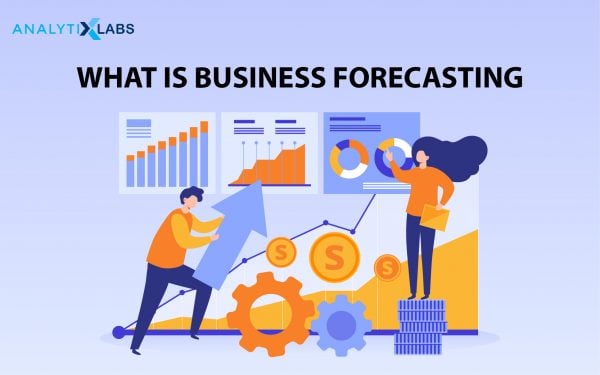
We all at one point or another have imagined how our life would have been if we knew what we know today. Imagine the catastrophe that could have been avoided if, for example, banking firms knew of the 2008 Global Recession or the profit that could have been made if investors knew of the potential of cryptocurrency. All of this leads to the need to develop strategies to forecast the future.
One must know that in Data Science, the terms “prediction” and “forecasting” differ significantly. Prediction refers to the prediction of a value by analyzing the relationship between a set of input variables and a target variable. On the other hand, forecasting is a whole different phenomenon that refers to foreseeing how some value or event would turn out to be over a period of time. Here, the past data is analyzed at the backdrop of time as the role of time is also taken into account to come up with the forecasted value.
While all businesses do some form of forecasting or other, the level of their business forecasting techniques can differ substantially. While a simple analysis can be done of the past data to understand the pattern and forecast the future of the business or economic events, other sophisticated statistical models can be put to use to know of the future. With the advancement of Machine Learning and Deep Learning, algorithms working under such an advanced setup can also be used.
Models of Business Forecasting
As mentioned earlier, there are various techniques through which business forecasting can be performed. These different business forecasting techniques give birth to the model of business forecasting where different techniques can be grouped as a model. There are mainly two types of models- Qualitative Models and Quantitative Models.
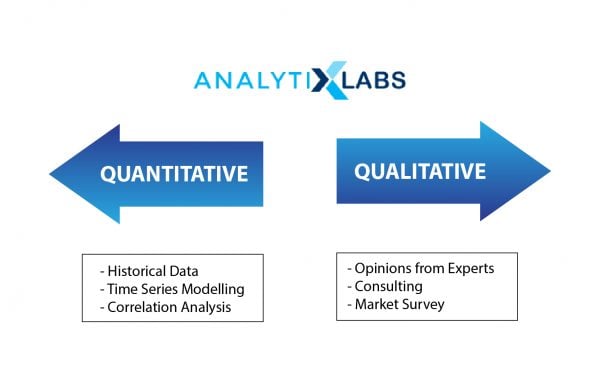
Qualitative Models
This forecasting model is used when trying to predict business important prediction over a short period of time. Here the business experts are consulted and their opinion forms one of the crucial inputs in coming up with the forecasted values. These business forecasting methods also are commonly used when there is a lack of historical data or the future seems too unstable to forecast using strictly a mathematical or statistical tool. While there are various methods that come under this model, the two most common business forecasting methods include Market Research and Delphi Model.
Quantitative Model
Unlike the Qualitative method with a human component involved in the forecasting that can potentially add to human bias or error in the process, the quantitative method solely relies on the historical data and understands the underlying pattern to know the future. This model is used when there is no dearth of historical data and there is a need to forecasting no only for the short term but medium or even long term. Among the Quantitative Model, there are a number of commonly used business forecasting techniques such as-.
Time Series Analysis
Time Series data focuses on the patterns found in the historical data and uses statistical methods to understand how time affects the target variable. Here, concepts such as analysis of the seasonality, trend, cyclicity, and irregularity found in historical data are used to understand the future better. This method emphasizes the use of statistics and methods such as ARIMA and SARIMA fall under it.
Econometric Method
Unlike Time Series analysis which uses the discipline of statistics, Econometric method uses a mathematically exhaustive technique to perform business forecasting. While Time Series analysis is used in a more general business environment, the econometric method is used in the world of academia to analyze the outcome of economic policies. The data used in such a form of analysis is highly complex and these techniques take into account factors such as the fluctuating significance of past data points and the fact that the impact of predictors on the target variable can change over time.
Indicator Approach
As the name suggests, this method is taken into account certain indicators to estimate the future. These indicators can be Key Performance Index (KPI) measuring the business performance, or government-provided data such as employment rate, inflation rate, GDP, etc. Here the relationship between these indicators is analyzed and uses the leading indicators to estimate the lagging ones.
While these are the main models of business forecasting, the readers must know that this is not the exhaustive list and other models such as projection models and casual models also exist that are used in specific scenarios.
What is Forecasting in Business?
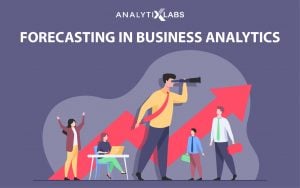
Business Analytics refers to that peculiar stream of analytics that deals with business and business-related problems. Often exploratory analysis is enough to understand the business scenario and bring to light the unknown facts by exposing hidden patterns inside the data. However, there are times when the business requires knowledge of the future and knowledge of the possible events that can happen in the future such as strikes, changes in demand, anomalies in the economy, or even the things that the competitors might do to change the business landscape drastically. While these examples are particular, these can be as simple as knowing the future sales, demand, etc to plan out logistics, inventory management or make the day to day processes more efficient. All these factors combined make the business leadership wish for tools that can predict the future so that they have enough time to prepare for and avoid catastrophic events. As this forecasting directly affects the business, it plays a crucial role in Business Analytics.
Today, Business Analysts need to come up with at least an annual forecast, make sure that the data is collected so that forecasted techniques can be implemented, and are tasked with making these projections available to the leadership in a simple, easy to understand manner. A good Business Analyst has to be good with the statistical and mathematical techniques and has to have good instincts, experience, business acumen, and economic policy knowledge to come up with accurate forecasts.
Elements of Business Forecasting
While there are various elements to any business forecasting model, some elements of forecasting form the core of any model and must be followed by anyone involved in the development of such models.
- Basic Development
The most basic elements of forecasting is setting up an in-depth process to know its current situations. This includes knowing the present stage the business is at and the development status of its various products. An analysis is also to be done regarding the present economic conditions, industrial policies, and the overall business scenario. This helps in knowing the starting point from where the forecasting is to be performed.
- Business Development
Once the basics of forecasting are developed, the next important element is to estimate the development of the business. This includes knowing the steps that the business is taking in the upcoming time to achieve some goals that the business leaders have in mind and the course of action the business is going to take. In addition to this, the upcoming conditions and plausible events that can happen in the concerned industry are estimated. This estimation is done based on experienced experts’ insight (qualitative model) or the analysis of the historical data (quantitative model) or both.
- Tuning of Model
This element focuses on the evaluation of the forecasting model by comparing the forecast done for a historical timeframe and comparing it with the actual values. Here the error needs to be quantified and then minimized by understanding the reasons for the error. These errors or deviations form the basis to fine-tune the model, take anomalies/outliers into account, and use different approaches until that method is figured out, which gives the best result.
- Implementing of Model
Once the model is finalized, the model is to be implemented to perform forecasting. On the basis of the forecasted values, business strategies are to be formulated and policies are to be driven. All of this must be done to keep in mind the error that can be there between the forecasted and actual values. The crucial element here is the perpetual improvement that is to be made in the data collection, model implementation, and other processes to maximize the accuracy of the forecasted values.
Importance of Business Forecasting
The importance of Business Forecasting can be understood once we understand the challenges different industries face and how forecasting can dramatically reduce those challenges. All these problems can be solved by forecasting different ranges viz. short, medium, and long term forecasting.
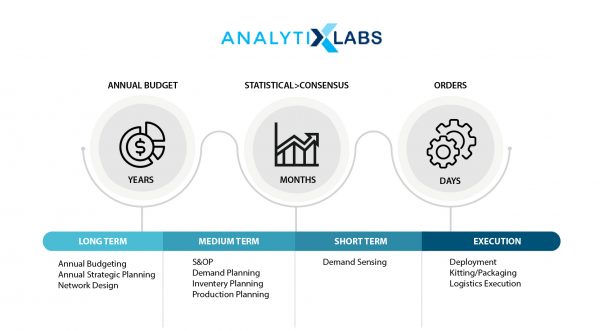
- Short Term Forecasting
This forecasting level is generally doney for up to 1 year (and is often less than 3 months). A business that faces challenges such as inventory management and needs to know the number of products to purchase this forecasting type. This idea can be extended to forecasting workforce requirements, job assignments, etc.
- Medium-Term Forecasting
The importance of business forecasting can be best understood here as often businesses face challenges in knowing the scenario that happens at a medium time range. This range is generally considered between 1 year (or 3 months) to 3 years. Business leaders often need to forecast sales, demand, profit, or loss to form strategies, budgets, and other things, which is where forecasting techniques come in handy. Also, businesses need to delve into research and development of products before time. The competitors don’t have the edge over them, and for this, demand for certain products is to be forecasted.
- Long Term Forecast
Forecasting is done over 3 years time span is considered as Long Term Forecasting. Her,n economic forecasting is often done,e such as understanding Macro Economic, which includes knowing of inflation, job requirements, money supply, etc. Knowing all this can help governments and other big entities to plan their policies accordingly.
Why is Forecasting So Important
Business Forecasting is useful in making a better decision and reducing the chances of a business venture to fail, however, forecasting in itself is also of high importance. Forecasting apart from the typical business environment can be used for other causes. For example, the most common forecast, weather forecast allows saving lives by alerting the authorities of natural calamities such as floods, hurricanes, etc.T his forecasting is now helping the government, NGOs, and other agencies prepare for contingencies such as water scarcity that can hit various countries in the near future, or the rising water levels that can engulf various coastal cities throughout the world.
You may also like to read about other important Data Mining Techniques & Methods
Conclusion: Authors Opinion
Everyone wants to know about the future, this has been the case for hundreds of years (e.g. since the Maya Civilization), thus no one can underestimate the importance of forecasting. Today, business forecasting is considered one of the most important and crucial aspects of any business working. Thus, any professional in the field of Data Science, Analysis, Strategist, or Policymaking need to know of the various methodologies and usage of forecasting and must use it to its full potential.
To get started with Business Forecasting, you can start learning from our premium business analytics learning materials. Have more doubts, you can also book a demo with us!
FAQs
- What do you mean by business forecasting?
Business forecasting refers to the field of forecasting that deals with forecasting business scenarios or events or predicting values over time that will be generated by a certain business. It has emerged as the most important aspect of planning and operating any form of business.
- What are the types of business forecasting?
There are multiple types of business forecasting. These include forecasting using experts with in-depth business knowledge,e which forms a kind of business forecasting model known as qualitative models. Another type is of a quantitative model that removes human involvement and purely uses data to perform forecasting. Business forecasting methods such as time series forecasting and econometric methods are considered part of it.
- How is forecasting used in business?
The importance of business forecasting can be understood by knowing the multiple ways in which various business entities use forecasting. Companies require forecasting to know their product’s demands or sales to manage their inventory to create budgets. Forecasting also helps to know the future profit or losses that a company might incur r, which can help create appropriate policies. Also, forecasting helps in knowing the future competition and the products that might be there in the market which can help the business to design better products. Apart from inventory and workforce management, forecasting can help the business leaders know of the future economic situation that can help them take important investment-related decisions.
- Engagement: Ask readers to post their queries & opinions in the comments below. So that we can help them out.
This article aimed at providing the reader with an understanding of Business Forecasting (and forecasting in general too), its role and importance in the world of Business, and the various techniques and models related to it. If you have any opinions or queries related to this article, please feel free to post and help us get more insights.
You may also like to read:
1. Top 40 Data Analyst Interview Questions & Answers

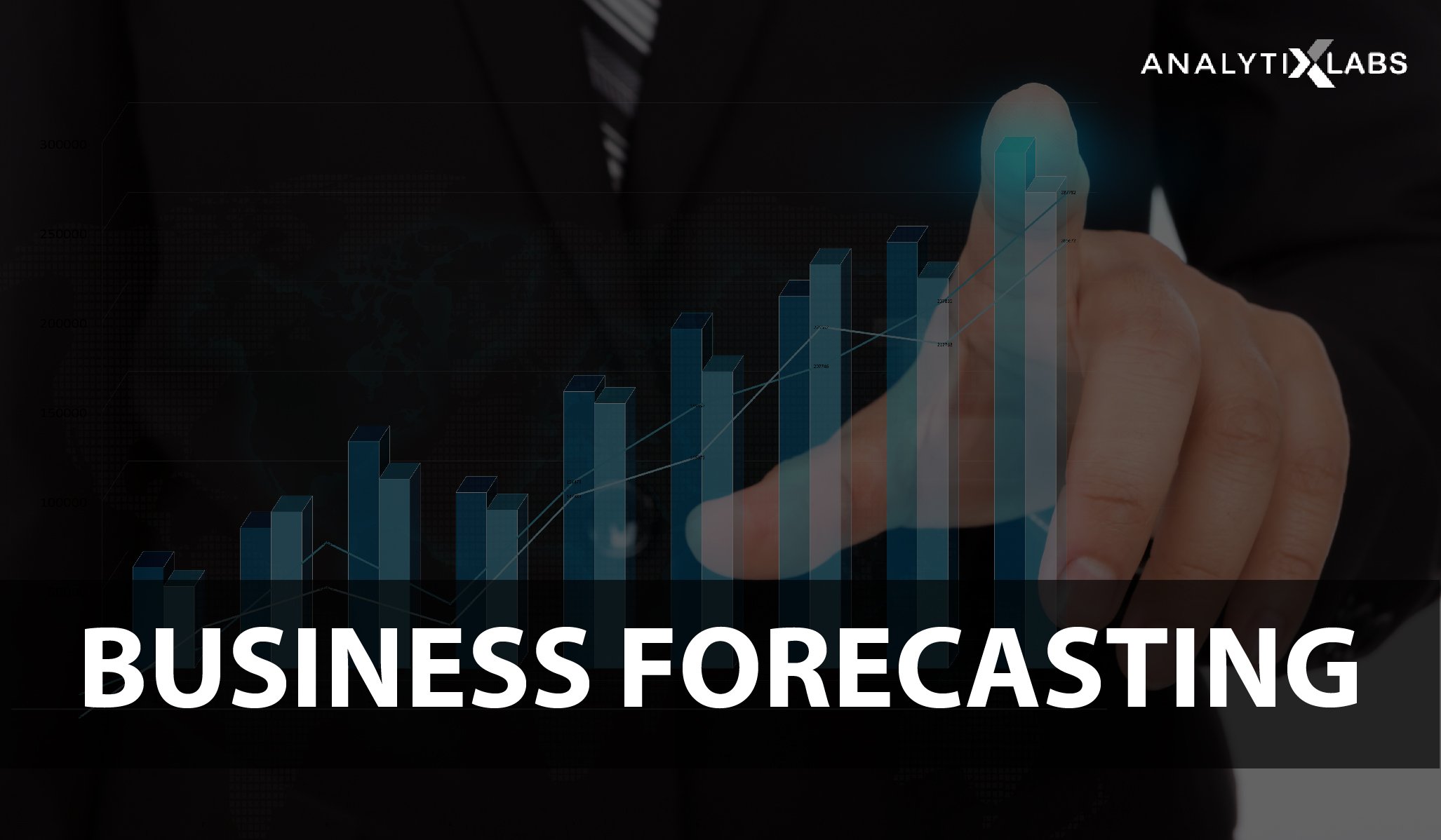







1 Comment
Your blog post on business forecasting models is a concise yet informative guide to the world of predictive analytics. I appreciated how you provided a comprehensive overview of various forecasting techniques and their applications in strategic decision-making.